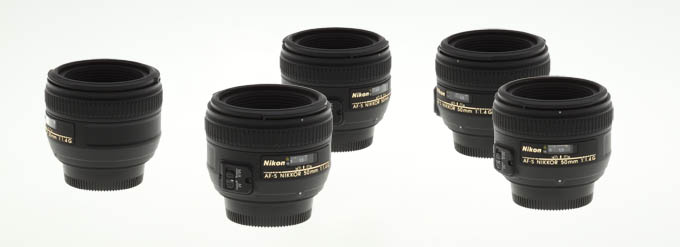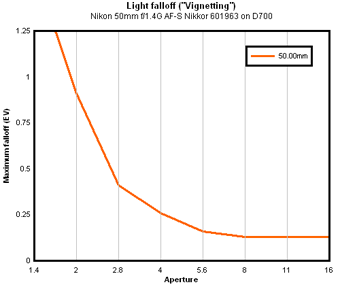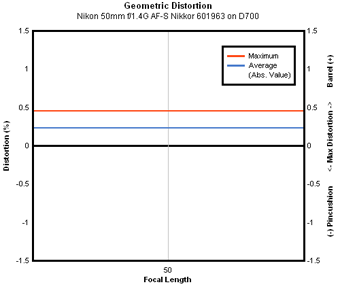The Nikon 50mm f/1.4G AF-S: a multi-sample evaluation
posted Sunday, February 14, 2010 at 10:12 AM EDT
Updated February 19, 2010: We've added some additional reading relating to other variation sample testing done on an external site, diglloyd.com. To skip to this new section, click here.
Introduction
As with most test organizations, the combination of time and resource constraints and relatively limited access to the review samples means that most of the time we can only test a single sample of each product, be it a lens or camera. Modern manufacturing is generally excellent at cranking out identical copies of a product, but the extraordinarily close tolerances involved in optical manufacturing mean that there's likely some noticeable variation from lens to lens. It's long been the case that photographers with deep pockets and lots of patience could often improve their lens kit by buying and testing several copies of each lens, selling on the lesser samples. The Internet is full of forum posts and web pages with people discussing lens sample variation, and more than a few examples have been posted, showing very noticeably different results from identical shots taken with different copies of the same lens. To the best of our knowledge, though, no one has thus far subjected multiple samples of lenses to rigorous, quantitative testing.
Sample variation is a significant issue for users, reviewers, and manufacturers. As a user, the issue is whether a positive review and glowing comments by other users mean that you'd have a similar good experience with a lens should you purchase a copy. On the flip side, do a few negative reports about a lens' performance mean you should avoid it, or are they merely flukes, with the majority of samples actually performing well?

In this article, we will provide the results of a comparison test between five samples of the same lens, in this case, the Nikon 50mm ƒ/1.4G AF-S. It's been often commented that the results of testing just one sample of a lens can lead to misleading results, as often there are better and worse samples of a given lens. To attempt to assess the impact of this claim, we have partnered with LensRentals.com to test several copies of the same lens.
Nikon 50mm ƒ/1.4G AF-S
The 50mm prime lens has been a stalwart companion to many a photographer, as the 50mm focal range is generally thought to replicate the same field of view as seen by the eye. Many budding photographers seek to get a ''nifty fifty'' in order to use a very wide aperture and produce photos with sharp subjects and blurred, out-of-focus backgrounds.
Until the release of the subject lens, the 50mm ƒ/1.4G AF-S, Nikon had produced (and continues to produce) two AF-D, screw-driven 50mm lenses, with ƒ/1.8 and ƒ/1.4 maximum apertures. When Nikon elected to produce ''screw-less'' consumer camera bodies such as the D40, D40x and D60, owners of those cameras were marginalized by rendering these older-style lenses partially incompatible with the newer cameras; the lenses will mount, and function properly, except the camera cannot autofocus the lens.
The release of the 50mm ƒ/1.4G, with its built-in AF-S motor, fills this gap, giving Nikon owners a brand-loyal option that was filled by the Sigma 50mm ƒ/1.4G EX DG HSM. The Nikon 50mm ƒ/1.4G is full-frame compatible; mounted on a sub-frame (DX) camera body, the lens will produce an effective field of view of 75mm.
The Nikon 50mm ƒ/1.4G AF-S ships with a circular-style, bayonet-mounted lens hood and accepts 58mm filters. The lens is available now for approximately $440.
Sharpness
In the following interactive graph, you'll see the five samples of the 50mm ƒ/1.4G, labelled from "A" to "E".
| #601963 ("A") | #608765 ("B") | #613401 ("C") | #616464 ("D") | #619319 ("E") |
The samples of the Nikon 50mm ƒ/1.4G we tested showed very different characteristics overall than did the samples of the Canon 50mm ƒ/1.4 USM, the subject of our first sample-variation test. The Canon versions were moderately sharp at the center of the frame when shooting wide open, but the corners were incredibly soft. The Nikons were softer at the center, but sharpness was much more uniform as you moved to the center.
While the five lenses were for the most part fairly similar, there were still subtle differences between them. In fact, given that the corners were more usable at maximum aperture, it could be argued that the differences between the lenses are actually more important than they were in the case of the Canons. Looking at the four lenses wide open, serial number 619319 was best in the corners, but a little soft and lumpy overall. 608765 and 616464 were OK in the center, but had one or more corners that were noticeably softer.
Stopping down to ƒ/2 significantly improved center sharpness on all samples, with 619319 doing the best, although differences were actually slight. Note that the shades of purple are separated by only about 1/4 blur unit, so one step's worth of difference would be almost impossible to detect. Two levels' worth of change would be observable, though. The two lenses with the softest corners remained fairly soft, particularly on the right side of the frame, but serial number 616464 was noticeably worse than the others, especially in the lower right corner. At ƒ/2, the difference in corner sharpness between 616464 and 619319 was pretty pronounced.
Once we stopped down to ƒ/2.8, though, sharpness differences between the five samples became negligible from there through ƒ/16.
Chromatic Aberration
| #601963 ("A") | #608765 ("B") | #613401 ("C") | #616464 ("D") | #619319 ("E") |
The Nikon 50mm ƒ/1.4 is a lens design with notably low chromatic aberration, so differences between the lenses in our sample is perhaps less significant as a result. That said, there were indeed interesting differences, in that the CA of some (619319) varied smoothly with changes in aperture, while others (608765 and 616464) varied more sharply. All samples had very low CA, but there were definitely differences to be found. It should also be noted that newer Nikon camera bodies such as the D700 employ automatic chromatic reduction, improving performance in this area substantially.
Corner shading

Distortion

Finally, corner shading and distortion were all but identical between the lenses, with maximum light falloff within a tenth of an EV of the 1.53 EV average.
Summary
At the end of the day, we again didn't find startling differences between the five samples, but we'd definitely prefer to own serial number 619319 than some of the others samples, thanks to its better performance in the corners.
The Nitty-Gritty details
Finally, if you would like to pore over the details for each lens, we have posted special pages just for you:
|
Serial Number |
Page |
|---|---|
| 601963 ("A") | LINK |
| 608765 ("B") | LINK |
| 613401 ("C") | LINK |
| 616464 ("D") | LINK |
| 619319 ("E") | LINK |
Other experiences with sample variation
Our experience with lens variation is far from unique; you can find references to it all over the Internet. Of particular note, though, are Lloyd Chambers' observations on the subject: Lloyd does some of the most thorough, rigorous experience-based lens tests anywhere on the 'net, so his reports carry particular weight. Most of his content is available only via subscription (a very worthwhile subscription indeed, we might add), but he has a free article posted on the topic that make for interesting reading:
To show that it's not just Canon or Nikon lenses that are subject to sample variation, Lloyd's also published an article on variation in Zeiss ZF/ZE lenses, although these are only available via subscription: